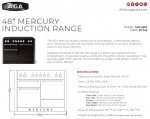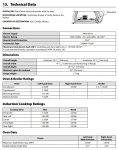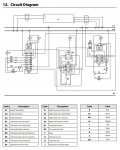ericwg
Member
- Location
- Sacramento, CA
- Occupation
- Associate Electrical Engineer
Hello All,
This is officially my first original post. Before I list my questions I want to say thanks to everyone that posts on this forum. I can't begin to tell you how much help it has given me over the years. Ok...onto the good stuff.
Before I list my questions I want to say thanks to everyone that posts on this forum. I can't begin to tell you how much help it has given me over the years. Ok...onto the good stuff.
Here is the situation, I have a three phase 208Y/120 panel via which I need to be able to power a single phase 240V electric induction oven. The datasheet for the oven calls for 240V (2 wire + N + Grd), 18.5kW. Furthermore, the install manual calls for Branch Circuit Protection of 50A. Admittedly, I am a little confused about the 50A BCP when 18.5kW equates to ~77A, but let's just skip that for now. In case someone suggests just running the oven at 208V...that maybe it just won't get as hot or will take longer to heat up, a rep from the manufacturer (AGA) confirmed that this oven will NOT operate correctly or be warrantied if operated at 208V. Thus, I'm not going to try that.
My plan was to employ a 16/32V boost transformer to get as close to 240V as possible. I understand an Autotransformer is an option as well...that it's similar to a boost transformer? Since I'm not clear on exactly which would be best to use, I mention both in my questions. My plan was to install this transformer in the Electrical room about 8 feet from the source panel. The range is then located ~30 feet away from the transformer. As I started to try to work out all the installation details for my plans, I realized there are a handful of questions I cannot answer RE: this setup. This is where I am hoping y'all can help out.
Branch Circuit Breaker:
What size (2-pole) breaker do I need for this circuit? If a 50A BCP is listed for use at 240V, the current would be higher at 208V. This is where my earlier confusion over the 50A breaker with an 18.5kW rating comes back into play. Not sure if this logic pans out, but with a 14.3% difference between 208V and 240V, should I assume that 50A BCP would increase to 50 X 14.3% = 57.2A, thus, a 60A breaker? I do know that 450.4(A) calls for an OCPD to be rated or set at not more than 125% of the rated full-load input current of the auto-transformer. Does that mean the OCPD should really be 57.2A X 125% = 71.5A...so 70A or 80A?
Primary/Secondary Transformer Protection:
1) Is primary and/or secondary protection required for boost / autotransformers?
2) If primary protection is required, does the branch circuit breaker provide it? If the boost really is akin to an autotransformer, then my understanding from section 450.4 (also Exhibit 450.6) is that the transformer I need would most likely be provided with a 2-pole disconnect switch with OCPD's (I assume fuses). If it isn't, I assume I could just specify one that is rated at the same current as the BCP? Would that cover the primary protection?
3) From what I am seeing, secondary protection is not required, but I would appreciate someone confirming this. If it is required, how is it typically provided?
Secondary Conductor OCP:
1) Is protection of the secondary conductors required? If so, how is it typically provided?
For clarification, there is a circuit diagram in the oven's install manual and though it shows multiple taps to L1 and L2, the N appears to pass through and not be used. There are also no control transformers shown in the circuit diagram. Lastly, in the "Connections" table there is a note referring to the "Maximum total electric load 240V (including oven fans, lights, etc.)". The fact that it mentioned 240V but not 120V, I can't help but wonder if this thing doesn't transform the 240V down to 120V for controls, lights, etc. BUT, for now, I am going to assume it does.
Providing a Neutral to the Load:
1) How do I provide a neutral to the load? In Exhibits 210.18 and 210.19 I don't see where I could tap either an autotransformer or boost transformer to get a neutral.
2) If I were to bring the neutral all the way from the panel to the oven, the line-neutral voltage would no longer be 120V, right? Please don't tell me I would need a second transformer for the neutral?
Sorry for the long post. Thanks for reading. I look forward to your responses.
-Eric
This is officially my first original post.
Here is the situation, I have a three phase 208Y/120 panel via which I need to be able to power a single phase 240V electric induction oven. The datasheet for the oven calls for 240V (2 wire + N + Grd), 18.5kW. Furthermore, the install manual calls for Branch Circuit Protection of 50A. Admittedly, I am a little confused about the 50A BCP when 18.5kW equates to ~77A, but let's just skip that for now. In case someone suggests just running the oven at 208V...that maybe it just won't get as hot or will take longer to heat up, a rep from the manufacturer (AGA) confirmed that this oven will NOT operate correctly or be warrantied if operated at 208V. Thus, I'm not going to try that.
My plan was to employ a 16/32V boost transformer to get as close to 240V as possible. I understand an Autotransformer is an option as well...that it's similar to a boost transformer? Since I'm not clear on exactly which would be best to use, I mention both in my questions. My plan was to install this transformer in the Electrical room about 8 feet from the source panel. The range is then located ~30 feet away from the transformer. As I started to try to work out all the installation details for my plans, I realized there are a handful of questions I cannot answer RE: this setup. This is where I am hoping y'all can help out.
Branch Circuit Breaker:
What size (2-pole) breaker do I need for this circuit? If a 50A BCP is listed for use at 240V, the current would be higher at 208V. This is where my earlier confusion over the 50A breaker with an 18.5kW rating comes back into play. Not sure if this logic pans out, but with a 14.3% difference between 208V and 240V, should I assume that 50A BCP would increase to 50 X 14.3% = 57.2A, thus, a 60A breaker? I do know that 450.4(A) calls for an OCPD to be rated or set at not more than 125% of the rated full-load input current of the auto-transformer. Does that mean the OCPD should really be 57.2A X 125% = 71.5A...so 70A or 80A?
Primary/Secondary Transformer Protection:
1) Is primary and/or secondary protection required for boost / autotransformers?
2) If primary protection is required, does the branch circuit breaker provide it? If the boost really is akin to an autotransformer, then my understanding from section 450.4 (also Exhibit 450.6) is that the transformer I need would most likely be provided with a 2-pole disconnect switch with OCPD's (I assume fuses). If it isn't, I assume I could just specify one that is rated at the same current as the BCP? Would that cover the primary protection?
3) From what I am seeing, secondary protection is not required, but I would appreciate someone confirming this. If it is required, how is it typically provided?
Secondary Conductor OCP:
1) Is protection of the secondary conductors required? If so, how is it typically provided?
For clarification, there is a circuit diagram in the oven's install manual and though it shows multiple taps to L1 and L2, the N appears to pass through and not be used. There are also no control transformers shown in the circuit diagram. Lastly, in the "Connections" table there is a note referring to the "Maximum total electric load 240V (including oven fans, lights, etc.)". The fact that it mentioned 240V but not 120V, I can't help but wonder if this thing doesn't transform the 240V down to 120V for controls, lights, etc. BUT, for now, I am going to assume it does.
Providing a Neutral to the Load:
1) How do I provide a neutral to the load? In Exhibits 210.18 and 210.19 I don't see where I could tap either an autotransformer or boost transformer to get a neutral.
2) If I were to bring the neutral all the way from the panel to the oven, the line-neutral voltage would no longer be 120V, right? Please don't tell me I would need a second transformer for the neutral?
Sorry for the long post. Thanks for reading. I look forward to your responses.
-Eric



